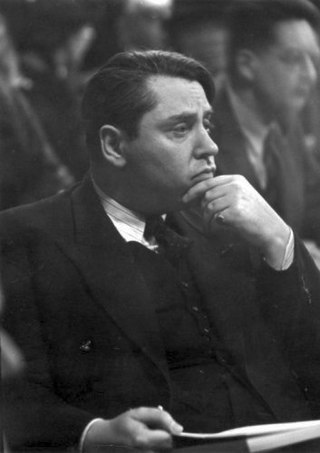
The Österreichische Galerie Belvedere is a museum housed in the Belvedere palace, in Vienna, Austria.

Nazi plunder was organized stealing of art and other items which occurred as a result of the organized looting of European countries during the time of the Nazi Party in Germany.

Jacques Goudstikker was a Jewish Dutch art dealer who fled the Netherlands when it was invaded by Nazi Germany during World War II, leaving three furnished properties and an extensive and significant art collection including over 1200 paintings, many of which had been previously catalogued as "Old Masters". The entire collection, which had been surveyed by Hermann Goering himself, was subsequently looted by the Nazis. Between the two World Wars, Jacques Goudstikker had been the most important Dutch dealer of Old Master paintings, according to Peter C. Sutton, executive director and CEO of the Bruce Museum of Arts and Science. Despite efforts of Goudstikker's widow after the war to regain possession of the collection, it was not until after her death that the Dutch government finally restituted 202 paintings to the Goudstikker family in 2006. To finance efforts to reclaim more of the stolen art, a large portion of them were sold at auction in 2007 for almost $10 million.

The Bavarian State Painting Collections, based in Munich, Germany, oversees artwork held by the Free State of Bavaria. It was established in 1799 as Centralgemäldegaleriedirektion. Artwork includes paintings, sculptures, photographs, video art and installation art. Pieces are on display in numerous galleries and museums throughout Bavaria.

The Museum Georg Schäfer is a German art museum in Schweinfurt, Bavaria. Based on the private art collection of German industrialist Georg Schäfer (1896–1975), the museum primarily collects 19th-century paintings by artists from German-speaking countries.
The Spoliation Advisory Panel advises the United Kingdom Government on claims for cultural property looted during the Nazi era.

Museum de Fundatie is a museum for the visual arts in Zwolle, Netherlands. Museum de Fundatie forms part of the Hannema-de Stuers Foundation, to which Kasteel het Nijenhuis in Heino also belongs. Museum de Fundatie possesses a collection of visual arts, with works ranging from the end of the Middle Ages until the present day, collected by Dirk Hannema, former director of Museum Boijmans Van Beuningen. As well as the permanent collection, Museum de Fundatie organises new, wide-ranging exhibitions every three months. Museum de Fundatie recorded a record number of 310,000 visitors in 2015.

Lippmann, Rosenthal & Co. or LiroBank originally a Dutch Jewish bank, was seized and used by Nazis for looting Jewish property during the German occupation of the Netherlands during World War II.
The Washington Principles on Nazi-Confiscated Art, formally the Washington Conference Principles on Nazi-Confiscated Art and sometimes referred to as the Washington Declaration, is a statement concerning the restitution of art confiscated by the Nazi regime in Germany before and during World War II. It was released in connection with the Washington Conference on Holocaust Era Assets, held in Washington, D.C., United States, on 3 December 1998.

Menzel v. List was a landmark restitution case involving Nazi looted art.
Hans Deutsch was an Austrian Jewish refugee, lawyer and publisher who played a key role in Holocaust reparations and art restitution cases in postwar Germany, and was the target of a judicial scandal known as the Deutsch Affair.

Many priceless artworks by the Dutch post-impressionist artist Vincent van Gogh were looted by Nazis during 1933–1945, mostly from Jewish collectors forced into exile or murdered.
The Hermann Göring Collection, also known as the Kunstsammlung Hermann Göring, was an extensive private art collection of Nazi Reichsmarschall Hermann Göring, formed for the most part by looting of Jewish property in Nazi-occupied areas between 1936 and 1945.
Rosa Oppenheimer was a German Jewish art dealer who was murdered in the Holocaust. The art she owned together with her husband Jacob is the subject of several high-profile restitution claims.
Johanna Margarethe Stern-Lippmann was a German Jewish art collector and victim of the Holocaust.
The Netherlands Art Property Collection is an art collection of recovered works of art that accrued to the Dutch state after World War II. This concerns works of art that were looted by the Nazi regime in the Netherlands or were purchased under duress or otherwise. The collection is managed by the Cultural Heritage Agency and is part of the national collection. The works may be on loan from Dutch museums or government buildings, and some are also stored in depots.
Richard Semmel was a German entrepreneur and art collector who was persecuted by the Nazis because of his Jewish heritage. His heirs have filed restitution claims for artworks.
Hugo Nathan (1861-1921) was a German Jewish banker and art collector.

Herbert Max Magnus Gutmann was a German banker and collector of Islamic art, persecuted by the Nazis because of his Jewish heritage.










